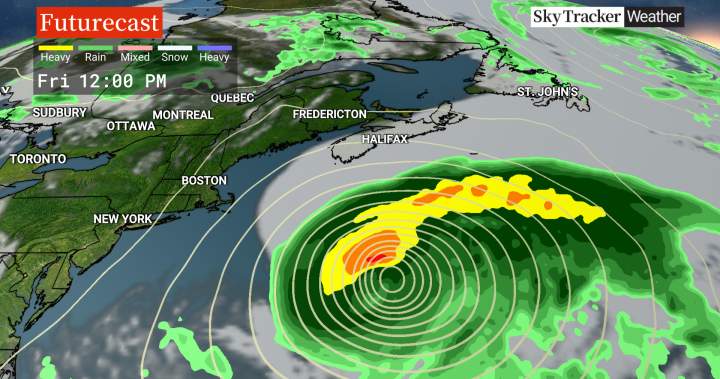The Atlantic Canadian coast is bracing for Hurricane Erin’s approach this weekend, with meteorologists warning of significant coastal impacts even as the storm’s center is expected to remain offshore. Weather models show Erin maintaining hurricane strength as it tracks northeast, running parallel to Nova Scotia’s shoreline by Saturday.
“While we’re looking at what appears to be a near-miss scenario, residents shouldn’t underestimate the reach of this weather system,” said Dr. Malcolm Reid, senior meteorologist at the Canadian Hurricane Centre in Halifax. “Hurricane-force winds can extend 100 kilometers from the center, and tropical storm conditions much farther.”
Current projections place Erin approximately 150 kilometers off Nova Scotia’s eastern shore at its closest approach, but coastal communities should prepare for sustained winds of 70-90 km/h with gusts potentially exceeding 120 km/h in exposed areas. Environment Canada has issued wind warnings for most of Nova Scotia’s Atlantic coast, with particular concern for Cape Breton Island.
Marine forecasts are particularly troubling, with wave heights expected to reach 7-9 meters in offshore waters. “The timing couldn’t be worse with astronomical high tides this weekend,” noted coastal erosion specialist Dr. Jennifer Morris from Dalhousie University. “We’re particularly concerned about coastal flooding and beach erosion along the Eastern Shore and Cape Breton.”
The storm comes as Nova Scotia continues recovery efforts from last year’s devastating Hurricane Fiona, which caused over $660 million in insured damages. Provincial emergency officials have activated their response centers as a precautionary measure.
“We’ve learned valuable lessons from Fiona,” said Emergency Management Office director Mark Furey. “Even though this storm isn’t expected to make landfall, we’re fully mobilized and coordinating with municipalities, utilities, and first responders.”
Nova Scotia Power has positioned repair crews strategically throughout the province, with additional resources on standby. Spokesperson Lisa Matthews confirmed that “approximately 300 line technicians and support staff will be deployed beginning Friday evening, with particular focus on coastal areas where salt spray combined with high winds typically causes the most infrastructure damage.”
Maritime residents are being advised to secure loose objects, prepare emergency kits with 72 hours of supplies, and stay informed through official channels as the forecast evolves. Particularly vulnerable are coastal roads, where storm surge combined with heavy rainfall could cause washouts and flooding.
“The most significant impacts will likely occur Saturday evening through early Sunday morning,” said Environment Canada warning preparedness meteorologist Bob Robichaud. “Even though the storm center will remain offshore, we’re still looking at a significant weather event for Nova Scotia’s eastern counties.”
As climate patterns continue shifting in the North Atlantic, how prepared are coastal communities for what appears to be an increasingly volatile hurricane season, and what long-term infrastructure adaptations might be necessary to withstand these recurring threats?










